- SaaS content marketing drives growth across acquisition, retention, and expansion by integrating education, trust, and product experience.
- Future-ready strategies emphasize adaptability through audience intelligence, lifecycle mapping, and data-driven content systems.
- High-performing SaaS teams treat content as a product function: measured, cross-functional, and continuously optimized for impact and scalability.
The SaaS landscape is shifting into an era where content functions as a growth engine across the full customer lifecycle. With AI, automation, and buyer sophistication accelerating, the boundaries between product, marketing, and customer success are rapidly dissolving. “After-SaaS” content marketing focuses on systems that educate, personalize, and build trust at scale, empowering teams to stay adaptable for the next wave of SaaS growth.
While the idea of “future-proofing” is appealing, the pace of change in AI, search, and content distribution makes any long-term certainty unrealistic. Rather than assuming strategies can be permanently future-proof, it’s more practical to focus on adaptability, building systems that evolve as technology, algorithms, and audience behaviors shift. In this sense, SaaS marketers should aim to be future-ready, not merely future-proof.
What SaaS Content Marketing Really Means
When I speak with SaaS founders or marketing leads, the conversation around content often starts with blog posts. But anyone with real experience in the space knows that content marketing for SaaS is a full-funnel, multi-touch discipline one that, when done right, impacts not only lead generation but also customer onboarding, retention, expansion, and community building.
So let me be clear: content isn’t a support function for SaaS growth, it’s the engine. It educates, builds trust, drives conversions, and keeps customers loyal in a space where churn can silently kill even the best products.
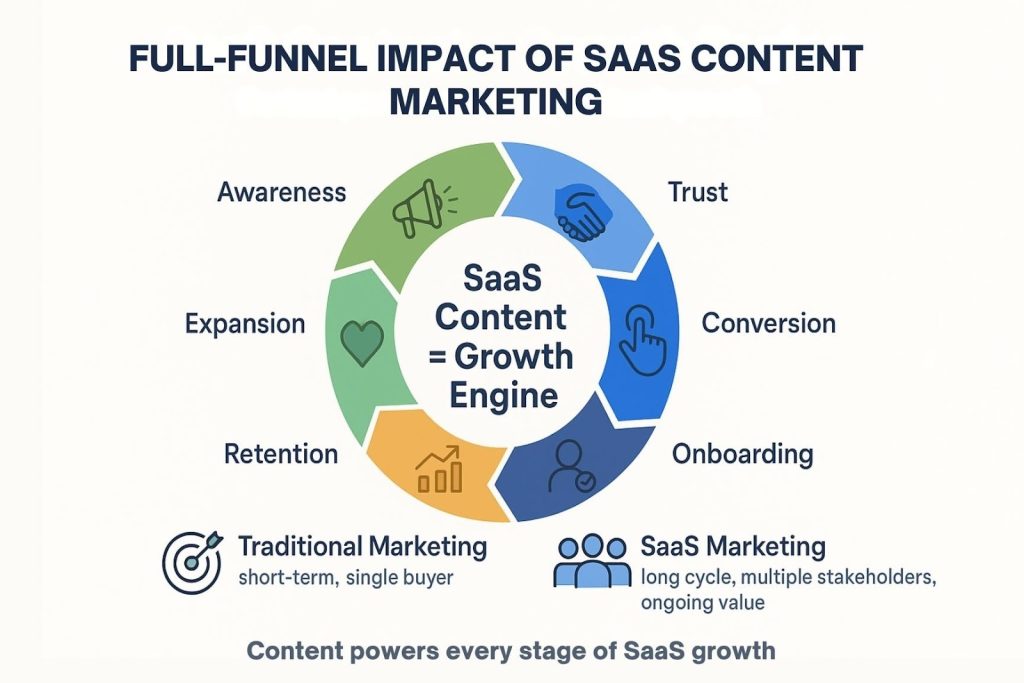
How SaaS Content Differs from Traditional Content Marketing
Content marketing in traditional sectors is often tied to product promotion or short sales cycles. SaaS flips that model. We’re dealing with complex, often intangible solutions. The buyers aren’t always the users. Decisions typically involve multiple stakeholders. The sales cycle can last weeks or months and the relationship doesn’t end after the sale. It’s just getting started.
In SaaS, content must:
- Explain abstract technical solutions in simple, compelling terms
- Appeal to both technical implementers and business decision-makers
- Educate users post-sale to ensure product adoption and reduce churn
- Continuously reinforce product value through the entire customer lifecycle
This makes the stakes higher and the opportunity greater. If you’re not treating content like a product function in itself, you’re leaving leverage on the table.
Strategy – Building a Scalable SaaS Content Engine
Let’s move into the core of what matters: building a SaaS content strategy that’s not just active, but actually drives results. I’ve seen too many teams fall into “random acts of content.” Don’t be that team.
Audience Intelligence: Start with the Org Chart, Not Just Personas
The first step is understanding who you’re actually selling to not just individuals, but roles inside companies. In SaaS, we’re rarely targeting a single person. You have:
- The implementer the end user who cares about UX, integrations, and support
- The buyer typically a manager or executive focused on ROI and risk mitigation
- The influencer could be someone in ops, IT, or compliance
Your content needs to address each of these stakeholders at their level of understanding, pain, and motivation.
Creating superficial personas isn’t enough. You need research: recorded sales calls, user interviews, customer success data, support tickets. The real gold is often buried in what your users complain about at 2 a.m. when the feature they don’t understand breaks. Your content should fix that problem before they even ask.
Content Mapping: Match Intent to Funnel Stage
Once you understand your audience, the next step is to architect your content against the buyer’s journey.
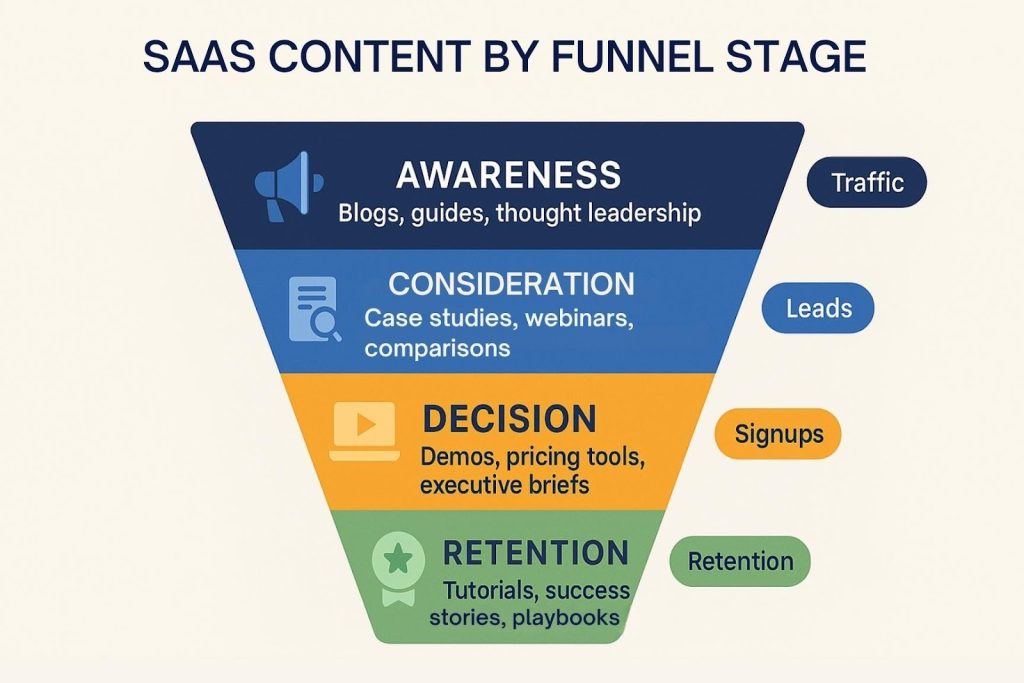
Here’s how I break it down:
Top of Funnel (Awareness)
The user is problem-aware, but not necessarily solution-aware. Your job isn’t to pitch. It’s to teach. Focus on:
- SEO-optimized blog content
- Informational guides
- Industry trend analysis
- Thought leadership
Success metric: traffic and first-party data capture (email, lead magnet opt-ins)
Middle of Funnel (Consideration)
Now they know the problem and are evaluating options. This is where you differentiate.
- Product comparisons (“Us vs Them”)
- Case studies with real metrics
- ROI-focused webinars
- Strategic whitepapers
Success metric: conversion to MQLs, time on page, demo/trial requests
Bottom of Funnel (Decision)
They’re considering you. Make it frictionless to say yes.
- On-demand product demos
- Interactive pricing calculators
- Implementation roadmaps
- Executive summaries for CFOs
Success metric: trial signups, opportunity creation, SQLs
Post-Purchase (Retention & Expansion)
This is where many teams go dark, a huge mistake. Your most profitable content may be the one that prevents churn.
- Onboarding tutorials
- Feature walkthroughs
- Success stories from power users
- Expansion playbooks for new teams/departments
Success metric: retention, activation rate, expansion revenue
SEO and Topic Cluster Strategy
SEO isn’t just a traffic engine, it’s your moat. The SaaS companies dominating search have built topic clusters: comprehensive coverage around a core subject with high-value internal links.
Let’s say you sell productivity software. Your pillar content might be “The Ultimate Guide to Remote Team Management.” Cluster content could include:
- “Best tools for asynchronous communication”
- “How to manage time zone differences”
- “Remote onboarding checklist”
This not only supports your SEO rankings it creates an educational ecosystem where readers spend more time with your brand and self-nurture through the funnel.
Content Calendar: Editorial Discipline Meets Agile Ops
Your calendar is your execution system. Treat it like a roadmap, not a wish list. I recommend planning content quarterly, mapped across funnel stages, target personas, and business goals. Don’t overfill it. Leave space for reactive content (product updates, industry news, or viral moments).
Use the calendar to enforce consistency. The best content teams aren’t the most creative, they’re the most consistent. Quality compounds. But not if you ghost your readers for three months.
Content Formats That Drive Results in SaaS
Let’s not pretend all content is created equal. In SaaS, the format you choose directly impacts not just who engages, but how far they move through your funnel. You need to be strategic, every content type serves a specific purpose in the buyer’s journey and user lifecycle.
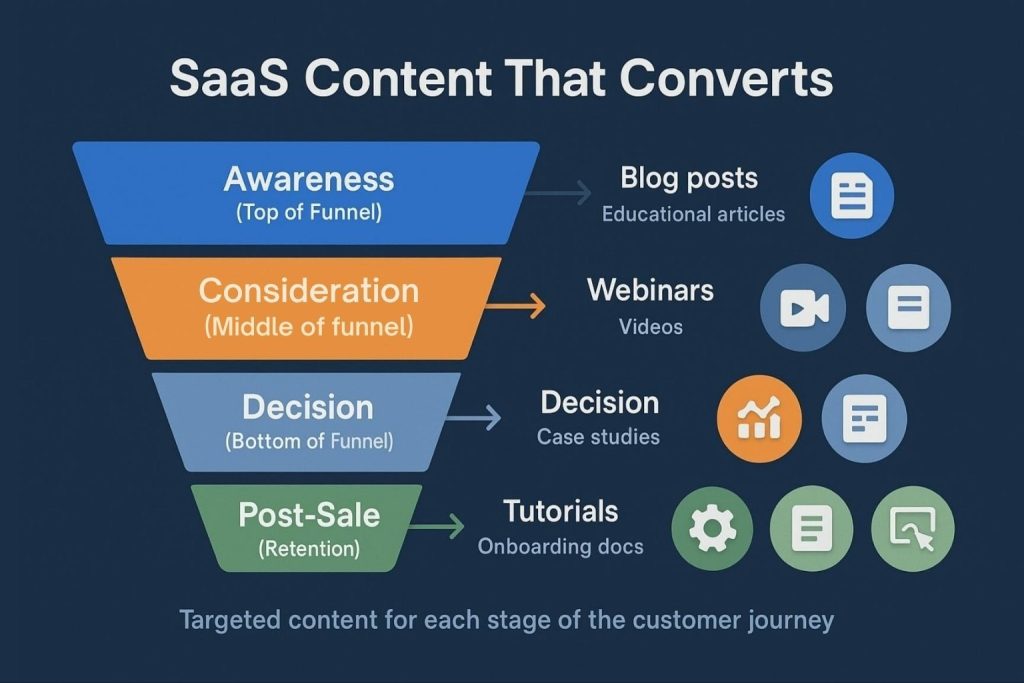
Below is how I approach content selection with SaaS teams I advise not just in theory, but based on what consistently delivers impact.
Blog Posts and Educational Articles
This is where most teams start, and for good reason. Blog content builds SEO authority, captures organic traffic, and educates readers. But only if it’s strategic.
Stop writing posts like “5 Productivity Tips for Remote Workers” unless you’ve found a keyword opportunity or a unique POV. Instead:
- Use keyword research to target queries with both search volume and commercial intent
- Write content that bridges your product category with a real problem
- Incorporate product-led content subtly like showcasing how your tool solves the issue without making the post a feature dump
Blogging isn’t dead. Bad blogging is. Treat your blog like a product test, optimize, and evolve it constantly.
Case Studies That Sell
A well-crafted case study is bottom-of-funnel gold. And I don’t mean those 300-word testimonials with vague quotes like “It changed our lives!”
I’m talking about:
- Clear business context: What was the customer’s situation before?
- Measurable outcomes: “Increased trial-to-paid conversion by 32% in 90 days”
- Visual assets: Screenshots, charts, even short video testimonials
The best case studies read like miniature success stories. Your sales team will reuse them. Prospects will cite them in calls. They’re not optional, they’re trust accelerators.
Webinars and Live Demos
Webinars are underutilized by early-stage SaaS teams, mostly because they sound resource-heavy. But a simple live session with a subject matter expert or product walkthrough can:
- Generate MQLs through gated registration
- Provide long-form engagement for serious buyers
- Fuel post-event content: blog recaps, quote snippets, video clips
What works best? Don’t just pitch your product. Instead, teach something. Position your tool as the means, not the end. Then offer a trial or follow-up 1:1 demo.
Videos: From Explainers to Feature Walkthroughs
There’s no excuse to avoid video anymore. Loom, Descript, and other tools have made it fast, low-cost, and scalable.
Types of videos that work well in SaaS:
- Explainer videos: 90-second animated or live-action overviews of what your product does and why it matters
- Feature tutorials: Show how to set up integrations, workflows, or advanced features
- Customer testimonials: Nothing beats a real human talking about how your product solved their pain
- Product launch teasers: Short, punchy videos to showcase what’s new
Add video to your landing pages, onboarding emails, knowledge base wherever people hesitate, use video to push them forward.
Whitepapers and Long-form Guides
When you’re selling into mid-market or enterprise, buyers need more than a blog post to convince stakeholders. That’s where long-form assets come in.
Whitepapers work best when they’re:
- Research-driven
- Vertically targeted
- Pain-point obsessed
For example, “The 2026 Guide to Risk Management in Healthcare SaaS” will do far better than “How to Stay Secure Online.”
Use long-form content to generate leads (via gated forms) or nurture late-stage deals. And yes, repurpose them into articles, decks, and infographics later.
Comparison and Alternative Pages
I’ve ranked #1 for “[Competitor] Alternative” and I can tell you these pages convert like crazy.
Why? Because the intent is off-the-charts bottom-of-funnel.
Build a page that compares your tool directly to alternatives. Include:
- Feature comparisons (with tables)
- Pricing transparency
- Unique differentiators
- Testimonials from switchers
Just keep it honest and not overly aggressive. The goal isn’t to trash competitors. It’s to position your product as the best-fit alternative for the right user.
Product-Led Documentation and Tutorials
Content isn’t just about acquisition it’s critical for activation and retention. This is especially true in self-serve SaaS.
Invest in:
- Onboarding guides with video and screenshots
- Step-by-step tutorials inside your help center
- “How to get value from [Feature X]” blog posts
- Release notes that explain not just what changed, but why it matters
This kind of content directly impacts support volume, NPS, and retention.
Interactive Content (If You’re Ready)
When you have the bandwidth, interactive content can be a force multiplier. Think:
- ROI calculators
- Product quizzes
- Industry benchmarks
- Workflow builders
These don’t just engage, they provide custom value. And the data collected helps your sales and marketing teams qualify leads faster.
But only build these if you’ve nailed the fundamentals first. Don’t use interactivity as a gimmick. Use it as a differentiator.
Distribution Getting Your SaaS Content in Front of the Right People
Creating excellent content is the price of admission. If nobody sees it, it doesn’t matter. Distribution is where I see the biggest gap in execution, especially among early-stage SaaS teams. They pour all their energy into the blog post, hit publish, and… that’s it. That’s how good content dies.
If you want your content to generate leads, fuel sales, and build your brand, distribution has to be baked into your process not an afterthought.
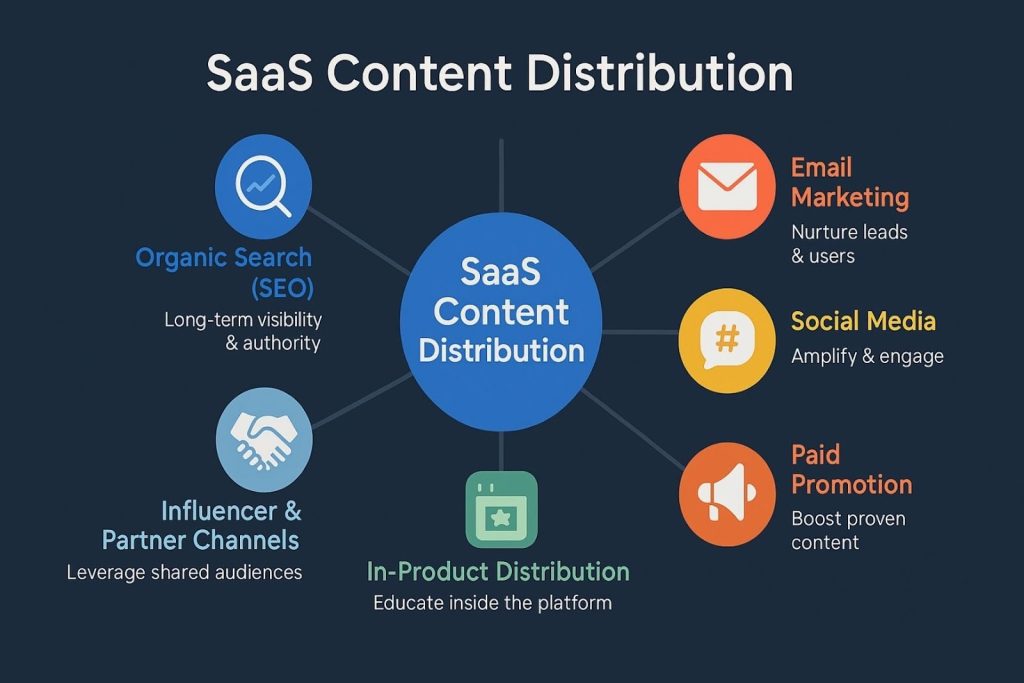
Organic Search (SEO): The Long Game That Pays Off
If you’re serious about sustainable inbound growth, SEO has to be part of your strategy. I’m not talking about keyword stuffing or hoping for contextual backlinks that actually improve authority to appear. I’m talking about structured, intentional SEO content marketing.
Here’s what I focus on:
- Search Intent: Don’t just target keywords; target problems. “CRM for startups” has a different intent than “how to organize your sales pipeline”. Know the difference.
- Content Clusters: Build around core topics with supporting content (pillar and clusters). Interlink everything to create topical authority.
- Technical Hygiene: Fast site speed, mobile optimization, clean URL structure, and a solid internal linking framework.
- Content Refreshes: Update your top-performing content every 6-12 months. It’s easier to climb rankings than to start from scratch.
I’ve worked with SaaS companies that went from 1,000 organic visits/month to 50,000+ simply by committing to a real SEO program over 12–18 months. It’s slow to start. Then it compounds. Just like ARR.
Email Marketing: Your Owned Channel for Depth and Recency
Most people treat their email list like a dumping ground for newsletters and promotions. That’s a waste. Email is your most direct, highest-leverage channel especially for nurturing leads and expanding customer usage.
Build your SaaS email engine to include:
- Drip campaigns that deliver value after someone downloads an asset or signs up
- Feature education for users during onboarding (triggered by behavior)
- Content newsletters for prospects not ready to buy but willing to stay informed
- Customer lifecycle campaigns to encourage upsells, referrals, or feedback
I segment lists obsessively by lifecycle stage, persona, industry, engagement level. The more relevant your content, the higher your open and conversion rates.
Use CTAs intelligently. Every email should either deliver insight or drive an action. If it does neither, delete it.
Social Media: Awareness, Amplification, and Community
Let’s be clear: social media doesn’t close most SaaS deals. But it can influence them heavily.
Here’s how I use social:
- LinkedIn: Thought leadership posts, customer spotlights, short-form educational clips, repurposed blog summaries
- Twitter/X: Engaging in topical conversations, sharing company news, teasing longer content
- YouTube: Home for product tutorials, webinars, and explainer videos (with strong metadata for discoverability)
- Slack/Discord communities: Share content contextually (not spam) in niche industry channels or user groups
What works best is repurposing. One webinar becomes 10 LinkedIn posts. One blog becomes a Twitter thread. One customer quote becomes a carousel graphic. You’re not flooding people, you’re reinforcing the signal.
And don’t just broadcast. Engage. The algorithm rewards creators who talk, not just post.
Paid Promotion: Fuel to Accelerate What’s Working
Content can (and should) scale without always paying to play. But when you’ve got a piece that performs organically, amplify it with budget.
My paid content go-tos:
- LinkedIn Ads for lead magnets (especially in B2B mid-market)
- Retargeting campaigns for blog readers or site visitors show them case studies, demo CTAs, or BOFU content
- Google Ads on branded and bottom-funnel keywords (“[Competitor] alternative”)
You don’t need a huge budget to make paid content work. You need targeting, timing, and relevance.
Don’t promote weak content. Paid media makes bad content fail faster.
Influencer and Partner Distribution
When people outside your company talk about you, it has 10x the impact.
Work with:
- Industry influencers for co-marketed webinars, joint guides, or guest posts
- Partners or integrations to do content swaps or bundle resources (e.g., “How to use our tool + Zapier to automate reporting”)
- Customers to turn them into evangelists showcase their stories, ask for contributions, feature them
Distribution doesn’t have to be limited to your channels. If someone else already owns the audience you want, partner your way in.
Your Product: The Best Distribution Channel You’re Ignoring
This is where I see serious leverage: embed content into the product itself.
- Show onboarding tutorials inside the app
- Use in-app messages to surface feature guides
- Add educational modals or tooltips linking to docs or videos
- Build a content center or help widget users can access contextually
Why does this matter? Because retention and product adoption often hinge on education. Don’t make users go find content. Put it where they already are.
And if you’re a PLG company this isn’t optional. It’s survival.
The SaaS Content Stack Tools You Actually Need
You don’t need an overwhelming Martech stack to run a great content program but you do need the right tools for your stage, your goals, and your workflows. I’ve worked with SaaS teams ranging from seed-stage startups to multi-product enterprises, and here’s what I recommend at each layer of the content process.
This isn’t a theory. These are the actual tools that make execution faster, more scalable, and more insightful.
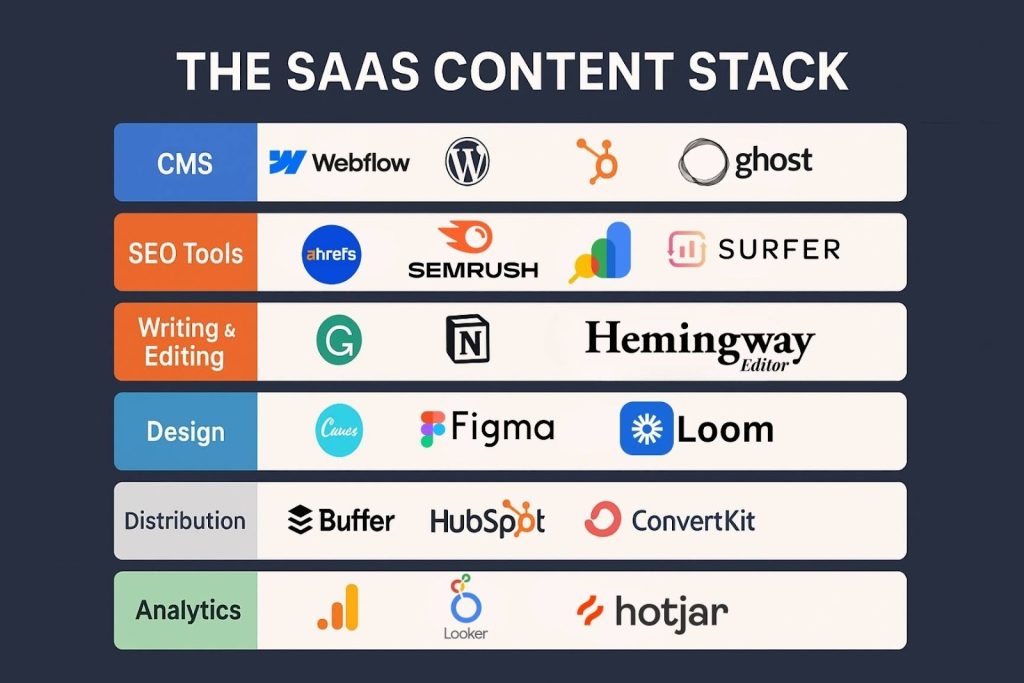
1. Content Management Systems (CMS)
Your CMS is the foundation. If it’s slow, clunky, or inflexible, your publishing velocity suffers. I’ve seen content calendars stall out for weeks because marketing had to wait on engineering to update a blog post.
Recommended CMS tools:
- Webflow – Perfect for agile teams that want visual control and quick iteration. Strong for design and performance.
- WordPress (with Elementor or Gutenberg) – Still a reliable workhorse, especially if you’ve already built domain authority on it.
- HubSpot CMS – Best if you’re already using their marketing automation suite and want everything integrated.
- Ghost – Clean, fast, and ideal if you’re focused purely on blogging and newsletters.
Tip: Make sure your CMS supports structured content (meta titles, descriptions, canonical URLs) and is easy for non-technical marketers to use.
2. SEO and Keyword Research
If you’re guessing at topics, you’re wasting time. You need real data on what people are searching for and what your competitors are ranking with.
Essential SEO tools:
- Ahrefs – My go-to for keyword research, backlink analysis, and SERP tracking.
- SEMrush – Great for competitive research and broader SEO audits.
- Google Search Console – Free and powerful for tracking indexed pages, queries, and click-through rates.
- Surfer SEO – Helpful for optimizing content length, keywords, and structure against top-ranking pages.
- Keywords Everywhere – Quick browser-based keyword volume checker.
You don’t need them all. Pick one major platform (Ahrefs or SEMrush), learn it well, and use GSC religiously.
3. Writing, Editing, and Content Ops
Content needs to be clear, on-brand, and consistent. Tools here help speed up production and maintain quality across a growing team.
Recommended tools:
- Grammarly – Solid baseline for grammar, clarity, and tone alignment.
- Hemingway Editor – If your content gets bloated, this helps cut fluff and tighten prose.
- Notion or Google Docs – For collaborative drafting, workflows, and internal documentation.
- Content Harmony – Helps with briefs, outlines, and content scoring against SEO benchmarks.
I also recommend using a shared content style guide and editorial checklist inside Notion or Confluence to keep tone and formatting consistent especially if you’re scaling a content team or working with freelancers.
4. Design and Multimedia
Even the best-written content underperforms when it looks outdated or boring. Invest in design tools early especially for long-form content, social distribution, and gated assets.
Go-to design tools:
- Canva – Ideal for marketers who aren’t designers. Great for blog images, social graphics, and lead magnets.
- Figma – For advanced teams with internal designers or design systems.
- Loom – Record quick explainer videos, product walkthroughs, or internal content reviews.
- Descript – For video editing, podcast transcription, and audiograms.
Brand consistency matters. Don’t underestimate how much visual trust impacts perceived credibility especially in crowded categories.
5. Content Distribution and Automation
You need tools that push content across email, social, and other channels without burning out your team.
Best distribution tools:
- Buffer or Hootsuite – For scheduling social content across platforms.
- HubSpot or ActiveCampaign – For email drip campaigns, contact segmentation, and lead nurturing.
- ConvertKit – A lighter alternative for SaaS teams focused on newsletters and creator-led content.
- Mutiny or Clearbit – For content personalization based on visitor behavior or firmographics (advanced but powerful).
Don’t spray and pray. Use automation to scale relevance, not just volume.
6. Analytics and Performance Tracking
This is where everything comes together. If you’re not measuring ROI or at least leading indicators you’re flying blind.
Critical analytics tools:
- Google Analytics 4 (GA4) – Track sessions, source/medium, engagement time, goal completions, and more.
- HubSpot or Salesforce Dashboards – Connect content to pipeline and revenue if you’re running lead-gen at scale.
- Databox or Looker Studio (formerly Google Data Studio) – Build custom dashboards for exec reporting or team visibility.
- Hotjar or FullStory – See how users actually engage with your content pages (scroll depth, click maps, rage clicks).
I also recommend tagging all campaigns with UTM parameters and using a structured content performance tracker (even a Google Sheet works) to monitor what’s actually driving traffic, conversions, and sales conversations.
Content Metrics That Matter How to Prove Real Impact
Let’s talk about measurement. Because if you can’t prove content is moving the needle, it becomes the first thing on the chopping block during budget season.
I’ve sat in rooms with SaaS execs who were skeptical of content’s value and I’ve changed their minds using hard numbers tied directly to revenue outcomes. But here’s the catch: you have to measure the right things, in the right way, at the right stage.
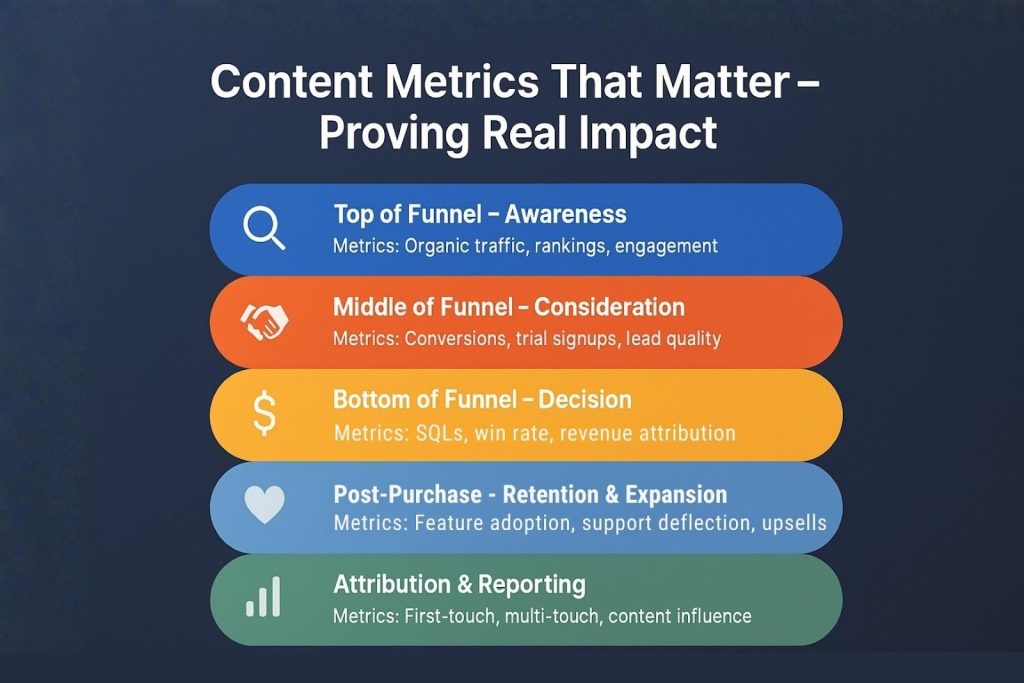
Start with Purpose-Built KPIs
Every piece of content should have a purpose. That purpose determines what you measure. Don’t default to generic metrics. Tie KPIs to the funnel stage, audience, and campaign objective.
Here’s how I break it down:
Top of Funnel Metrics (Awareness)
These show whether you’re capturing attention and driving discovery.
- Organic traffic – Sessions from search to your content pages (via GA4 or GSC)
- Keyword rankings – For core terms, tracked over time
- Bounce rate & time on page – Quality indicators for relevance and content-match
- Social shares and mentions – Especially for thought leadership and viral reach
- New email subscribers or lead magnet downloads – First-party data capture
You’re not looking for sales here, you’re looking for traction and qualified eyeballs.
Middle of Funnel Metrics (Consideration)
Now you’re evaluating engagement, trust-building, and lead intent.
- Content-assisted conversions – Which posts or assets contributed to lead gen (via attribution modeling)
- Demo requests or trial signups – Especially from retargeting and BOFU pages
- Form fills on gated assets – Whitepapers, comparison guides, or webinars
- Lead quality (MQLs) – Volume is meaningless if your leads can’t close
I often use a combination of HubSpot (or CRM data) and GA4 goals to map content to funnel progression.
Bottom of Funnel Metrics (Decision)
This is where marketing and sales alignment really kicks in. You want to track:
- SQLs influenced by content – Did this person read the pricing guide or view the case study?
- Sales cycle acceleration – Did content reduce time from demo to close?
- Win rate – Especially if sales reps used specific assets in deal stages
- Revenue attribution – Tie specific content to deals using CRM notes, UTMs, or last-touch attribution
This is more complex, but more valuable. Tools like Dreamdata, Attribution App, or custom-built Looker dashboards help connect these dots.
Post-Purchase Metrics (Retention & Expansion)
This is content’s secret weapon. If your retention is strong, your growth is exponential. If it’s not, content can help.
Measure:
- Onboarding completion rate – Do users engage with tutorials or docs?
- Feature adoption – Track usage before and after a content campaign (e.g. new integration guide)
- Support deflection – Did content reduce tickets or FAQs?
- Upsell conversion rate – Tie success stories or playbooks to expansion behavior
- NPS or CSAT trends – Did a content refresh correlate with happier users?
Most of this will come from product analytics tools like Mixpanel, Amplitude, or Segment and should be cross-referenced with your content calendar.
Attribution: Understand What Content Influences What
Here’s where most teams go wrong: they expect content to convert cold traffic in one click. But that’s not how SaaS buying works.
Content often plays a supporting role, not a closing one.
Use these models to get a clearer picture:
- First-touch attribution – Credit content that brings someone into your world
- Multi-touch attribution – Show the full path from awareness to conversion
- Content scoring – Assign weighted values based on influence stage (e.g., blog post = 10, comparison guide = 40)
If you’re using HubSpot, Salesforce, or a modern CRM, this is doable. Even a simple UTM tracker in Google Sheets goes a long way if you’re early-stage.
Qualitative Signals Matter Too
Don’t ignore the non-numeric feedback:
- Did a sales rep tell you a post helped close a deal?
- Did a customer success manager forward a tutorial to save a renewal?
- Did prospects cite your blog in discovery calls?
- Are competitors copying your content ideas?
These are strong signals. Add them to your internal reporting. They may not show up in dashboards, but they absolutely reflect influence.
Cadence: Report Monthly, Analyze Quarterly
I advise SaaS teams to report content performance monthly and keep a pulse on what’s live, what’s driving traffic, and what’s being used.
But do your strategic analysis quarterly. That’s when you’ll see trends:
- Topics that consistently perform
- Gaps between traffic and conversion
- Channels where you’re underutilized
- Customer behavior shifts tied to product releases
Don’t just report for the sake of it. Use the data to shape your roadmap. What you publish next quarter should be informed by what worked last quarter.
Best Practices That Separate Winning SaaS Content Teams from the Rest
By this point, you know that SaaS content marketing isn’t about writing a few blog posts and hoping leads roll in. It’s a discipline. A growth lever. A strategic advantage. But very few companies execute it at a high level. The difference between those who do and those who don’t? It comes down to how they operate, not just what they publish.
Here are the best practices I’ve seen in high-performing SaaS content teams, the ones consistently driving pipeline, adoption, and expansion.
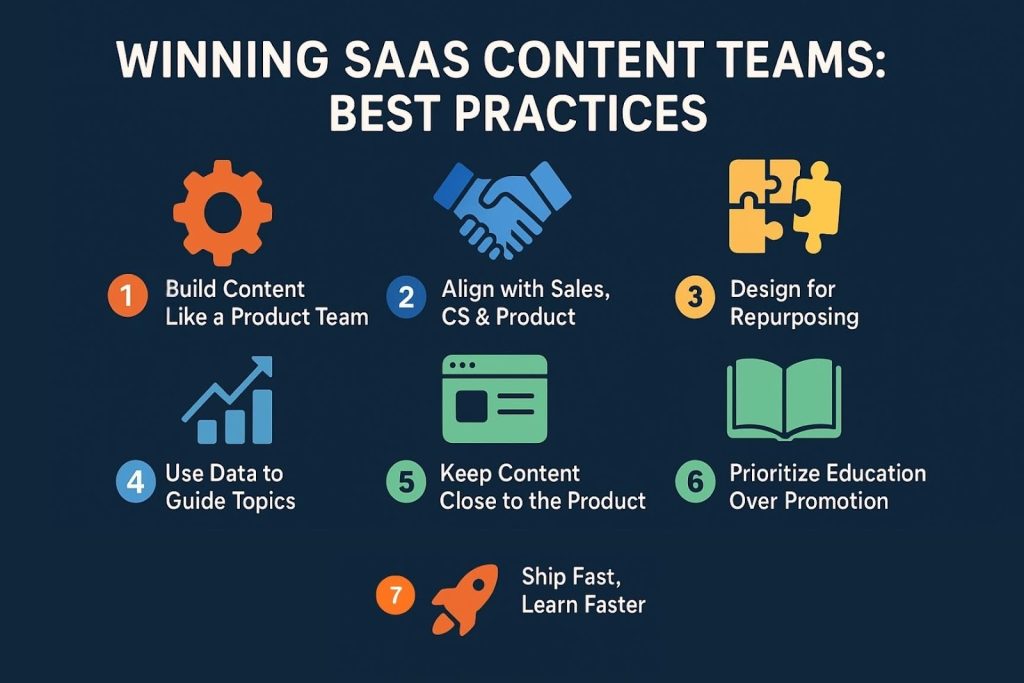
1. Build Content Like a Product Team Would
Treat your content roadmap like a product backlog. You wouldn’t build a new feature without user research, feedback loops, QA, and version control so don’t do that with content either.
What this looks like in practice:
- Maintain a content backlog in Notion, Asana, or ClickUp, with prioritization by impact and effort
- Use briefs for every major piece audience, goal, funnel stage, keywords, CTA
- Run editorial standups or async updates to keep velocity without micromanagement
- Conduct post-mortems on underperforming content to learn what went wrong
This operational rigor separates serious teams from scattered ones.
2. Align with Sales, CS, and Product Early and Often
Content shouldn’t live in the marketing silo. Your best insights come from the people talking to customers daily.
Build recurring touchpoints with:
- Sales: Get feedback on what content helps close, what’s missing, and which objections they hear most often
- Customer Success: Source post-sale content needs, like onboarding gaps or feature confusion
- Product: Coordinate launches, updates, and roadmap context to build supporting content that drives adoption
I’ve seen massive success with shared Slack channels like #content-requests or #field-feedback where GTM teams can drop ideas in real time.
3. Design Content for Repurposing from Day One
Smart content marketers think in systems. They never create a single asset without a plan to slice and reuse it.
Examples:
- A whitepaper becomes 3 blog posts, a webinar script, a LinkedIn carousel, and a short YouTube explainer
- A customer interview fuels a case study, a quote for social proof, and a podcast segment
- A product feature launch gets a doc update, in-app tooltip, demo video, and announcement email
This multiplies the return on every content investment. It also supports omnichannel visibility so you stay present without creating net-news every time.
4. Don’t Create Content in a Vacuum Leverage Data
Avoid the trap of creating what you think is useful. Let the data talk.
Where to look:
- Search console & SEO tools: What topics are people already finding you for?
- CRM or call transcripts: What objections or questions keep surfacing?
- On-site behavior: Which posts convert or get shared? Where are users dropping off?
- Community platforms: What’s trending in your ICP’s Slack groups, forums, or Discords?
I also run quarterly customer surveys with a simple question: “What content would make your job easier?” That one prompt can fill a roadmap.
5. Keep Content Close to the Product
The best SaaS content is inseparable from the product, and strong UX and SEO alignment helps create that connection. It doesn’t just talk about industry trends, it demonstrates how your solution fits into the workflow, solves the problem, or delivers a specific outcome.
Ways to keep product and content tightly linked:
- Use real screenshots instead of generic stock visuals
- Reference product use cases directly in blog posts
- Build product-led content e.g., “How to automate reporting with [Tool Name] in 5 minutes”
- Create contextual onboarding content embedded inside the UI
You’re not marketing content. You’re marketing outcomes and the product is the path.
6. Prioritize Educational Value Over Promotion
Trust is earned by helping people solve real problems. And that means teaching, not pitching.
What this means in action:
- Make the value of the content standalone, even if the reader never buys
- Use first-party data, real use cases, and actionable advice
- Respect reader time. No filler. No fluff. No buried ledes.
In my experience, the content that gets shared, bookmarked, and referenced in Slack threads is the content that teaches first and sells second.
7. Ship Fast, Learn Faster
Perfectionism kills velocity. Great content teams ship with 80% confidence, then learn and iterate.
How to build this muscle:
- Use MVP content launch a lean version, test, then expand
- A/B test headlines, CTAs, and hero images
- Track performance weekly not just at the end of the quarter
- Revisit underperforming pieces and improve instead of starting over
This is how you build compounding gains. Every asset becomes a working experiment, not a one-off campaign.
Common Pitfalls Why SaaS Content Programs Fail and How to Avoid It
I’ve seen a lot of SaaS content strategies fail and it’s rarely because the team didn’t care or wasn’t talented. It’s usually because of blind spots, internal misalignment, or a mismatch between effort and expectations.
Let’s break down the most common reasons content programs stall or crash and how to avoid them.
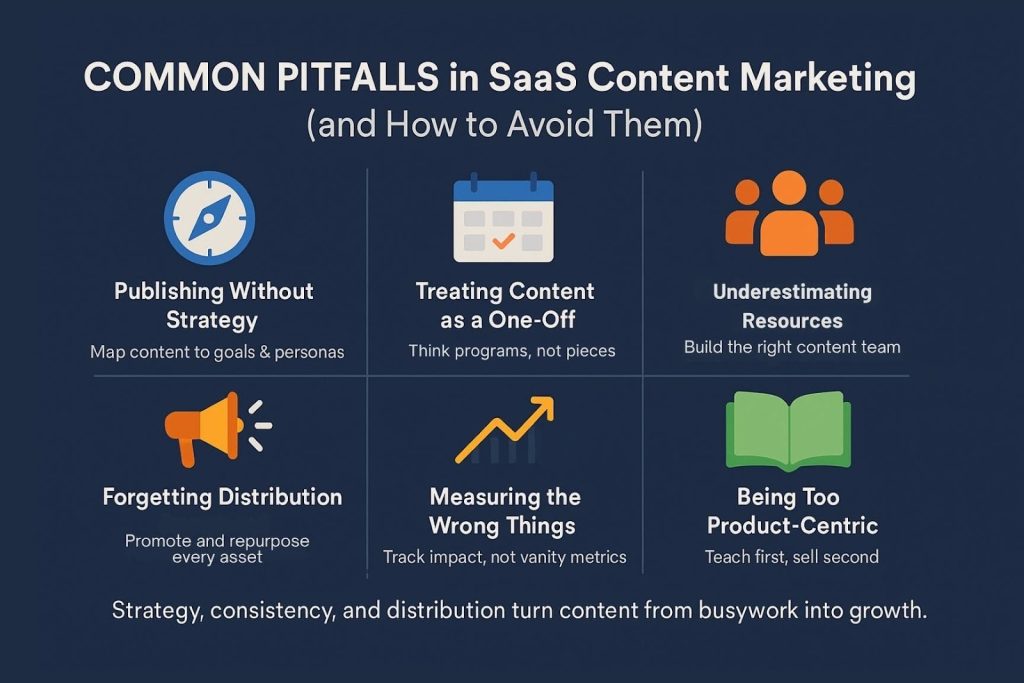
1. Publishing Without Strategy
This is probably the most frequent issue I see. Teams start writing because they feel they should, not because they have a clear plan.
What it looks like:
- Publishing random blog posts on disconnected topics
- Chasing SEO volume without tying keywords to business goals
- Producing content with no CTA or next step
How to fix it:
- Start with your funnel. Map content to specific lifecycle stages and personas.
- Every piece should serve a defined purpose: traffic, conversion, nurture, or retention.
- Create an editorial calendar aligned with company goals, product launches, and customer needs.
Don’t just hit publish. Aim.
2. Treating Content as a One-Off Project
Content isn’t a campaign. It’s an engine. But too many teams treat it like a one-time push, a guide here, a case study there and then stop.
The result? Flat traffic. Zero momentum. No compound impact.
How to fix it:
- Think in programs, not pieces. Build topic clusters. Establish recurring formats (e.g. monthly product updates, quarterly reports).
- Measure results over quarters, not weeks.
- Invest in refreshes. Often, updating an old high-performing post yields more ROI than writing a new one from scratch.
Consistency is what builds authority. Not occasional bursts of effort.
3. Underestimating the Resources Required
This one’s tough. Content is deceptively labor-intensive. Research, writing, editing, design, distribution it takes time, skill, and cross-functional support.
Where it goes wrong:
- Expecting one marketer to do it all
- Hiring a freelancer with no SaaS or domain experience
- Launching a content plan with no budget for design, video, or promotion
How to fix it:
- Be honest about your internal capabilities. Start smaller if needed, but do it well.
- Build a content squad: writer, editor/strategist, designer (shared), and a marketing ops resource.
- If outsourcing, onboard freelancers properly. Give them ICP profiles, product demos, past examples, don’t just hand them a topic and expect gold.
Quality takes investment. But done right, content pays for itself many times over.
4. Forgetting About Distribution
You’ve heard me say it before: if no one sees your content, it doesn’t matter.
And yet, this remains a top reason for failure.
Signs of poor distribution:
- Publishing content only to your blog with no amplification
- No email workflow or segmentation to support new assets
- Relying purely on organic traffic without building link equity or authority
How to fix it:
- Treat distribution as part of content creation, not a separate step
- Build distribution playbooks for each content type: blog, video, gated asset, etc.
- Repurpose ruthlessly. Get 10–15 uses from every major asset.
- Align with demand gen and product marketing. Content should power campaigns, not compete with them.
Without distribution, your content is a well-built boat left on dry land.
5. Measuring the Wrong Things (Or Nothing at All)
Content isn’t fluff unless you treat it that way. If you’re only measuring pageviews or social likes, you’re missing the point, and you can learn from real-world SEO success stories that show what impact truly looks like
Measurement mistakes I see:
- Using vanity metrics as proof of success
- No attribution setup, so content impact is invisible to sales
- No feedback loop between content performance and content planning
How to fix it:
- Tie every asset to funnel metrics (traffic, leads, pipeline, retention)
- Use UTMs, CRM notes, and sales input to track influence
- Build dashboards that tell a story, not just a data dump
- Ask: What changed because we published this?
Content’s value is real. You just have to be willing to track it.
6. Being Too Product-Centric (Too Soon)
It’s tempting to talk about your product all the time, especially in a startup where everyone lives and breathes it.
But your audience doesn’t care yet. Not until they understand their own problem and trust you to help solve it.
What to avoid:
- Writing feature-first content that assumes the reader already wants to buy
- Overusing “we” instead of speaking to the reader’s context
- Gating all valuable content behind forms
How to fix it:
- Lead with value. Teach first, sell second.
- Use stories, analogies, and customer examples to create relevance.
- When you do mention the product, do it contextually as a tool, not the hero.
Content is a conversation, not a pitch deck.
Real-World Examples SaaS Companies Getting Content Marketing Right
Let’s wrap with what matters most. It’s one thing to talk strategy; it’s another to show companies executing SaaS content at a high level.
I’m not just listing big names here. These are brands that consistently create high-impact content across the funnel and do it with intention, consistency, and creativity.
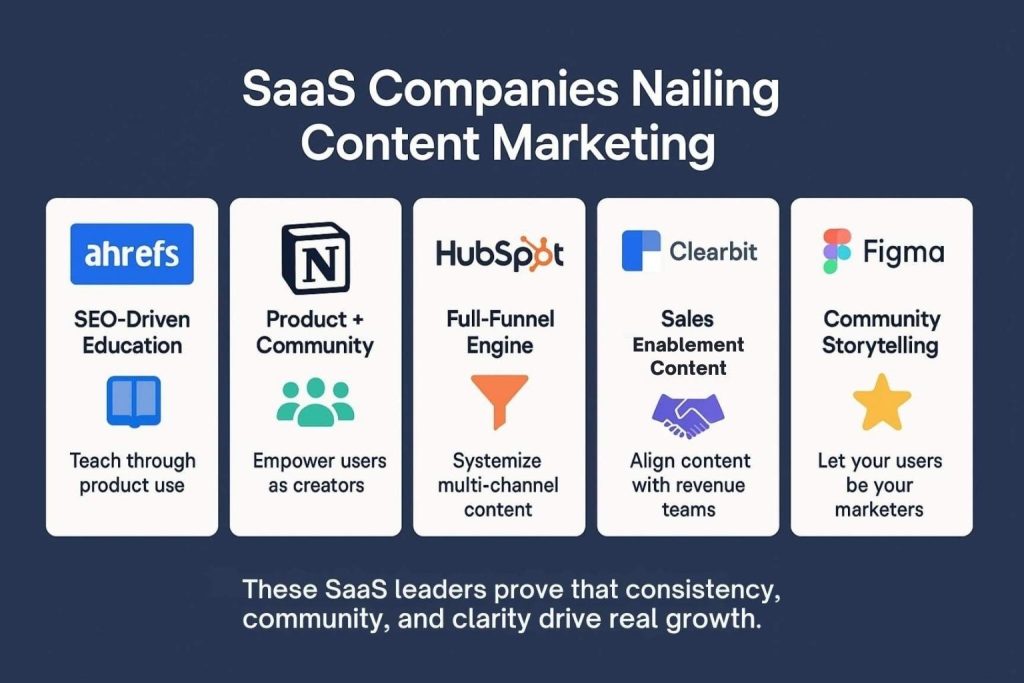
1. Ahrefs SEO-Driven Education That Converts
Why they stand out:
Ahrefs is one of the best in the game at turning complex topics into digestible, high-value content that directly supports product usage.
- Their blog is an SEO powerhouse they target strategic, high-intent keywords, often ranking #1 or #2 globally.
- They don’t just write about SEO they teach it, using Ahrefs as the tool of choice in every example.
- Their YouTube channel is also a case study in product-led video education over 400k subscribers and counting.
Takeaway: Build content that doesn’t just explain what shows users how, and make your product the natural solution along the way.
2. Notion Product-Led Content Meets Community-Driven Strategy
Why they stand out:
Notion does a phenomenal job blending elegant product storytelling with community-generated content.
- Their template gallery is a content engine in disguise; each template is a use case, often created by power users, and it drives organic discovery.
- They create in-app tutorials, onboarding tours, and help docs that double as long-tail search content.
- Their YouTube series and launch videos feel more like Apple than a SaaS startup with high production value, human storytelling, and extremely feature-relevant.
Takeaway: Make your customers the heroes of your content, and let the product experience flow naturally from that.
3. HubSpot Multi-Channel, Full-Funnel Excellence
Why they stand out:
HubSpot is the blueprint for scaled B2B content operations they’ve been doing inbound before it was cool, and they haven’t slowed down.
- Their blog strategy is segmented by persona and funnel stage (marketing, sales, service, etc.) with lead magnets tightly integrated.
- Their free tools (e.g., email signature generator, website grader) drive massive top-of-funnel traffic and convert.
- Their academy teaches prospects and customers alike, blending SEO with retention and loyalty.
Takeaway: If you’re operating at scale, you need systems. Build content engines that span blog, video, tools, courses, and email all orchestrated with CRM and product insights.
4. Clearbit Intentional Content for Sales Enablement
Why they stand out:
Clearbit creates content that arms both marketers and sales reps with messaging that aligns to real business problems.
- They publish industry-specific guides that pair technical depth with business outcomes ideal for sales conversations.
- Their benchmarks, reports, and integrations content don’t just teach, they drive urgency.
- They’ve also mastered comparison pages and “alternative to” content that pulls in high-intent prospects actively evaluating solutions.
Takeaway: Content isn’t just for inbound. Think about how your content can enable revenue teams and shorten sales cycles.
5. Figma Community-First, User-Centric Storytelling
Why they stand out:
Figma understood early that their power users were their best content creators so they built a strategy around that.
- Their community hub allows users to share templates, files, and plugins effectively turning users into content producers.
- They host and share design systems, team workflows, and use cases that inspire people to build with Figma.
- Their event content, including Config (their annual conference), is repackaged into micro-content across social and email.
Takeaway: Let your audience tell the story then amplify it. Build infrastructure around community-led content.
Final Thoughts
SaaS content marketing isn’t just a traffic strategy. It’s a business growth engine. When executed well, it accelerates every part of the customer lifecycle:
- Attracts the right people
- Educates and qualifies leads
- Enables sales and shortens cycles
- Onboards and activates customers
- Increases retention and expansion
- Turns users into evangelists
It’s not easy. But it’s worth every ounce of investment if you build it right.
If you’ve read through this full guide, you now have the frameworks, tactics, examples, and mindset required to elevate your SaaS content strategy.
Don’t just publish. Don’t just produce. Build a content function that drives growth. The market’s crowded but there’s still massive upside for teams willing to play the long game with discipline and creativity.
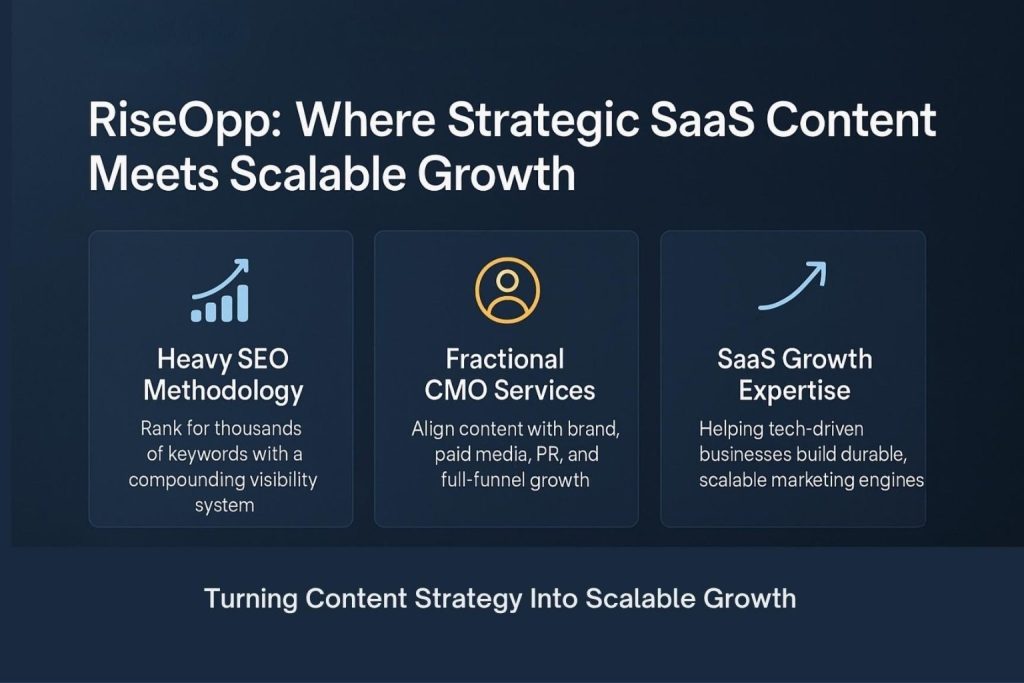
About RiseOpp Where Strategic SaaS Content Meets Scalable Growth
At RiseOpp, we don’t just believe in the power of content marketing we’ve built our company around helping SaaS and tech-driven businesses harness it strategically. As a Fractional CMO and SEO services firm, we work with high-growth companies across industries to design and execute marketing strategies that deliver real business outcomes not vanity metrics.
For our SEO clients, we deploy our proprietary Heavy SEO methodology, a proven framework for ranking a site for tens of thousands of keywords over time. It’s a system that goes far beyond blog posts or backlinks. It’s about building a durable foundation of long-term visibility that compounds.
But content doesn’t live in a vacuum. Through our Fractional CMO services, we help SaaS companies integrate content into the bigger picture aligning it with brand positioning, performance channels (like Google, Meta, LinkedIn, and TikTok Ads), email automation, PR, affiliate marketing, and more. Whether it’s mapping content to the buyer journey, shaping messaging that cuts through, or building out a marketing team from scratch we’ve done it.
If you’re serious about turning content into a true growth engine not just an activity let’s talk. We’ll help you turn strategy into momentum.
Comments are closed